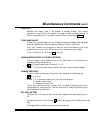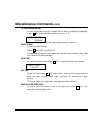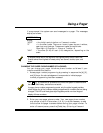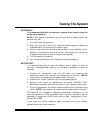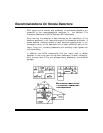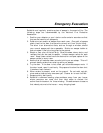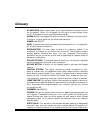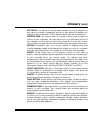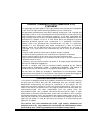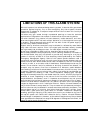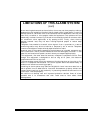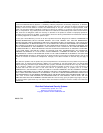
- 28 -
Glossary (cont)
EXIT DELAY: The period of time allowed between turning the system on
and leaving through a designated exit/entry door before the system will
register an alarm condition. This is determined at the time of installation.
INTERIOR ZONE: An interior zone is a group of points that protect the
interior of your premises. You may want to turn the perimeter portion of
your system on while leaving the interior zones off to allow you to open
interior doors and pass interior motion detectors without causing an alarm.
KEYPAD: A keypad is your link into your system. It displays alarm and
trouble messages, shows faulted zones and allows you to turn the system
on/off by using the buttons. Your system will have one or more keypads.
ON/OFF: These terms refer to the burglary portion of your security
system. There are several levels of operation that allow you to protect part
of your premises while you remain inside. Fire sensors and other
emergency and environmental features are always active and ready; they
are not affected in any way by turning the burglary portion of your security
system on or off. Other terms used are "armed" (system is on) and
"disarmed" (system is off). See ON-INSTANT, ON-STAY, and STAY.
ON/OFF INDICATOR: Red light in the upper portion of the keypad labeled
"Armed." When lit, some part of the burglar alarm system is on; when not
lit, the burglary portion of the system is off.
ON-STAY: A system setting that turns on the perimeter protection of the
building but allows movement throughout the interior.
PANIC BUTTON: A push button that allows you to signal the central station
that you need immediate assistance. Your system has programmable
Keypad Send Help Alerts that can also serve as Panic buttons.
PERIMETER ZONE: A perimeter zone is a group of points that protect the
exterior of your premises. Your outside doors and windows would be
programmed as a perimeter zone.
SENSOR: The actual alarm sensor, detector or device installed to detect an
intrusion, fire, or environmental problem. Examples include: door contacts,
window contacts, motion sensors, glassbreak sensors, smoke detectors,
rate-of-rise heat detectors, temperature sensors, flood/water sensors, and
carbon monoxide gas detectors.




